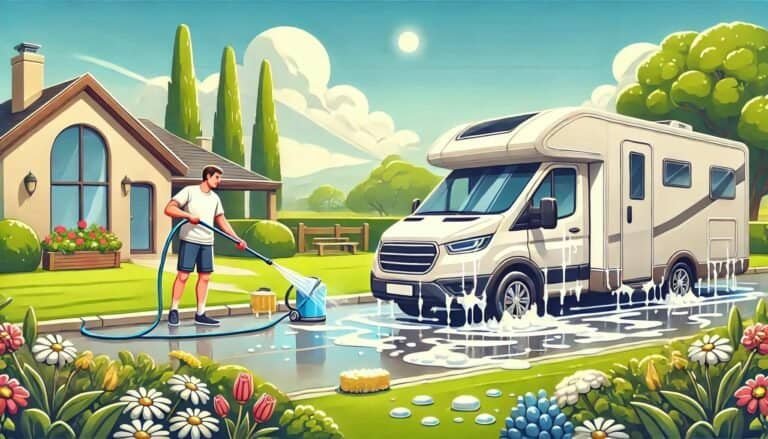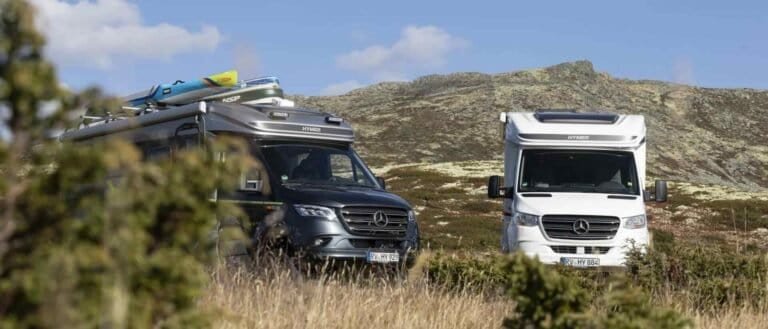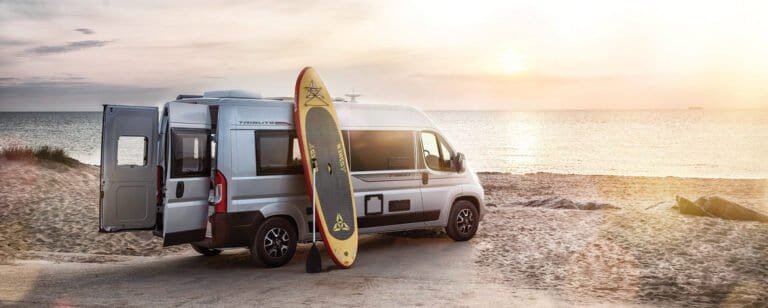Winterising your campervan or motorhome is crucial to protect it from the harsh conditions of the colder months. Neglecting this essential process can lead to significant damage, resulting in costly repairs. This guide will walk you through the steps necessary to prepare your vehicle for winter, ensuring it’s ready for your next adventure when spring arrives.
Key Takeaways
- Winterising your campervan or motorhome prevents damage from cold weather.
- Key areas to focus on include the exterior, interior, plumbing, electrical system, and engine.
- Proper winterisation ensures a smooth transition back to use in spring.
Why Winterising is Essential
Properly winterising your campervan or motorhome is essential to prevent damage caused by freezing temperatures, moisture, and inactivity. Water left in pipes can freeze and expand, causing cracks and leaks. Batteries can lose charge or get damaged, and the engine can suffer from neglect. By taking the time to winterise your vehicle, you protect your investment and ensure it’s ready for use when the weather warms up.
Preparing the Exterior
Cleaning and Inspecting the Exterior
Start by thoroughly cleaning your campervan or motorhome. Remove any dirt, grime, and debris that can cause damage over time. Inspect the exterior for any cracks, rust spots, or damage that needs repair before winter.
Protecting Tyres, Windows, and Seals
Check the condition of your tyres and inflate them to the recommended pressure. Consider using tyre covers to protect them from UV damage and harsh weather. Inspect all windows and seals for leaks and apply a suitable sealant if necessary to prevent moisture from entering.
Covering Your Vehicle
Investing in a high-quality cover designed for campervans or motorhomes is a wise choice. A good cover will protect your vehicle from snow, ice, and moisture, preventing potential damage to the exterior and interior.
Interior Preparations
Cleaning and Organising the Interior
Clean the interior thoroughly, removing any food crumbs or debris that could attract pests. Organise and store items securely to prevent damage during storage.
Checking for Leaks and Insulating Windows
Inspect the interior for any signs of leaks, particularly around windows and doors. Apply insulation to windows and doors to help maintain a stable interior temperature and reduce condensation.
Removing Perishable Items and Preventing Pests
Remove all perishable items from your campervan or motorhome, including food, toiletries, and any other items that can spoil or attract pests. Use pest deterrents, such as traps or natural repellents, to keep rodents and insects at bay.
Plumbing System
Draining and Flushing the Water System
Drain all water tanks, including the freshwater tank, greywater tank, and blackwater tank. Flush the system thoroughly to remove any residual water.
Adding Antifreeze to Prevent Freezing
Add non-toxic RV antifreeze to the plumbing system to prevent any remaining water from freezing. Follow the manufacturer’s instructions for the correct amount and method.
Checking and Protecting Pipes and Tanks
Inspect all pipes and tanks for signs of wear or damage. Use pipe insulation or heat tape to protect exposed pipes from freezing temperatures.
Electrical and Battery Care
Disconnecting and Storing Batteries
Disconnect the batteries and store them in a cool, dry place. If possible, use a battery maintainer or trickle charger to keep them charged over the winter.
Maintaining the Battery Charge
Check the battery charge periodically and recharge as needed to ensure they are ready for use in spring.
Checking Electrical Systems and Appliances
Inspect all electrical systems and appliances for any issues. Address any problems before storing your campervan or motorhome for the winter.
Engine and Fuel System
Adding Fuel Stabiliser
Before storing your campervan or motorhome for the winter, add a fuel stabiliser to the fuel tank. This will prevent the fuel from degrading and causing issues in the fuel system. Run the engine for a few minutes to ensure the stabiliser circulates throughout the system.
Changing Oil and Filters
Change the oil and oil filter before winterising your vehicle. Fresh oil will help protect the engine components from moisture and contaminants that can cause corrosion and damage.
Protecting the Engine and Fuel Lines
Inspect the engine for any signs of leaks or damage. Check all belts, hoses, and fuel lines for wear and replace as needed. Consider using an engine fogger to coat internal engine components with a protective oil film, preventing rust and corrosion during storage.
Additional Tips
Storing Your Campervan or Motorhome
Choose a suitable storage location for your campervan or motorhome. An indoor storage facility is ideal, but if that’s not possible, look for a sheltered, dry area away from trees and other hazards. Ensure the vehicle is parked on a level surface and use wheel chocks to prevent movement.
Regular Maintenance Checks During Winter
Even when your campervan or motorhome is in storage, it’s important to perform regular maintenance checks. Visit your vehicle periodically to inspect for any signs of damage, leaks, or pest infestations. Maintain the tyre pressure and check the battery charge as needed.
Preparing for Spring Reactivation
When spring arrives, take the time to carefully reactivate your campervan or motorhome. Remove any protective covers, reconnect the batteries, and inspect all systems. Flush the plumbing system to remove any antifreeze and refill the water tanks. Check the engine, fuel system, and electrical systems to ensure everything is in working order.
FAQ Section
1. Why is it important to winterise my campervan or motorhome?
Winterising your campervan or motorhome prevents damage from freezing temperatures, moisture, and inactivity. It helps protect your vehicle’s plumbing, electrical, and engine systems, ensuring it’s ready for use when the weather warms up.
2. How often should I check my campervan or motorhome during winter storage?
It’s recommended to check your vehicle at least once a month during winter storage. Look for any signs of damage, leaks, or pest infestations, and maintain tyre pressure and battery charge as needed.
3. What type of antifreeze should I use in my campervan or motorhome?
Use a non-toxic RV antifreeze specifically designed for recreational vehicles. Follow the manufacturer’s instructions for the correct amount and method of adding it to your plumbing system.
4. Can I use a regular car cover for my campervan or motorhome?
It’s best to use a cover specifically designed for campervans or motorhomes. These covers provide better protection against the elements and are tailored to fit your vehicle’s size and shape.
5. How do I prevent pests from entering my campervan or motorhome during winter storage?
Remove all perishable items from the interior, clean thoroughly, and use pest deterrents such as traps or natural repellents. Inspect and seal any openings where pests could enter.
6. What should I do if I find a leak in my campervan or motorhome during winter storage?
If you discover a leak, address it immediately. Repair or replace any damaged seals, windows, or components to prevent further damage. Ensure the interior is dry and ventilated to avoid mould and mildew.
7. How do I maintain my campervan or motorhome batteries during winter?
Disconnect and store the batteries in a cool, dry place. Use a battery maintainer or trickle charger to keep them charged, and check the charge periodically throughout the winter.
8. What steps should I take to prepare my campervan or motorhome for spring reactivation?
Remove protective covers, reconnect batteries, flush the plumbing system, and refill water tanks. Inspect the engine, fuel system, and electrical systems, and perform any necessary maintenance to ensure everything is in working order.
9. Can I perform winterisation myself, or should I hire a professional?
Many campervan and motorhome owners choose to perform winterisation themselves. However, if you’re unsure about any steps or prefer peace of mind, hiring a professional can ensure the job is done correctly.
10. What are the risks of not winterising my campervan or motorhome?
Failing to winterise your vehicle can result in frozen pipes, damaged plumbing, dead batteries, engine issues, and overall deterioration. This can lead to costly repairs and reduced lifespan of your campervan or motorhome.
Conclusion
Winterising your campervan or motorhome is a crucial step in protecting your investment and ensuring it’s ready for use when spring arrives. By following the steps outlined in this guide, you can prevent damage from cold weather and keep your vehicle in top condition. Take the time to winterise properly, and you’ll enjoy many more adventures on the open road.







